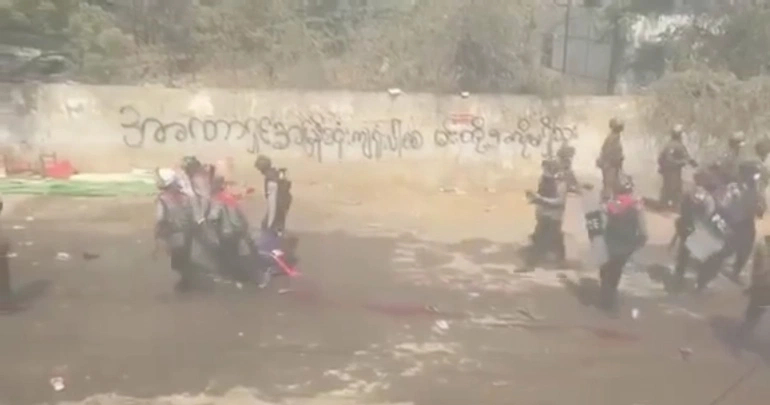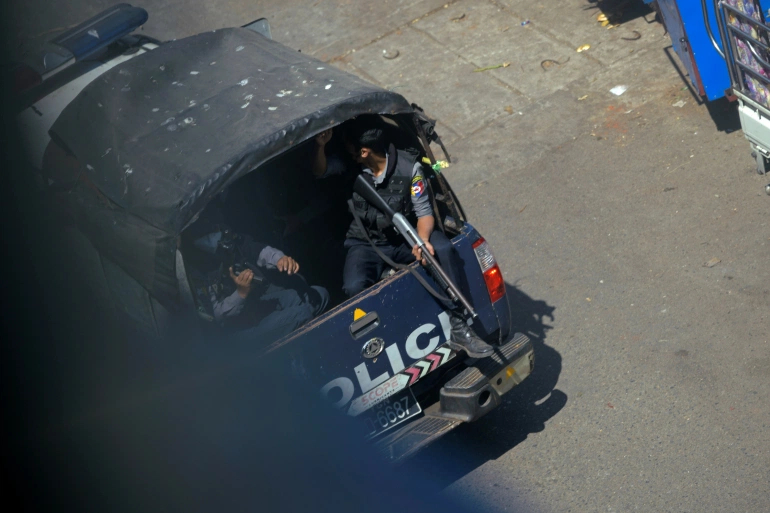‘Shoot Till They Are Dead’: Police Who Fled Myanmar Reveal Orders
SPECIAL FEATURE, 15 Mar 2021
Al Jazeera - TRANSCEND Media Service
Police officers who fled to India give first-hand accounts of how military ordered them to shoot peaceful protesters.
10 Mar 2021 – When Tha Peng was ordered to shoot at protesters with his submachine gun to disperse them in the Myanmar town of Khampat on February 27, the police lance corporal said he refused to do so.
“The next day, an officer called to ask me if I will shoot,” he said. The 27-year-old refused again and then resigned from the force.
On March 1, he said he left his home and family behind in Khampat and travelled for three days, mostly at night to avoid detection, before crossing into India’s northeastern Mizoram state.
“I had no choice,” Tha Peng told the Reuters news agency in an interview on Tuesday, speaking via a translator. He gave only part of his name to protect his identity. Reuters saw his police and national ID cards which confirmed the name.
Tha Peng said he and six colleagues all disobeyed the February 27 order from a superior officer, whom he did not name.
Reuters could not independently verify his or other accounts gathered near the Myanmar-India border.
The description of events was similar to that given to police in Mizoram on March 1 by another Myanmar police lance corporal and three constables who crossed into India, according to a classified internal police document seen by Reuters.
The document was written by Mizoram police officials and gives biographical details of the four individuals and their account of why they fled. It was not addressed to specific people.
“As the Civil Disobedience Movement is gaining momentum and protest(s) held by anti-coup protesters at different places we are instructed to shoot at the protesters,” they said in a joint statement to Mizoram police.
“In such a scenario, we don’t have the guts to shoot at our own people who are peaceful demonstrators,” they said.
FYI: U Jarmal was a bodyguard of Daw Aung San Suu Kyi.#WhatsHappeningInMyanmar #MilkTeaAlliance #mar1coup https://t.co/H7V65QCsRY
— Ro Nay San Lwin (@nslwin) March 10, 2021
Deaths and detentions
Myanmar’s military, which detained members of the country’s elected government and staged a coup on February 1, did not respond to a Reuters request for comment.
The military has said it is acting with restraint in handling what it has described as demonstrations by “riotous protesters”, whom it accuses of attacking police and harming national security and stability.
Tha Peng’s is among the first cases reported by the media of police fleeing Myanmar after disobeying orders from the military’s security forces.
Daily protests against the coup are being staged across the country and security forces have cracked down. More than 60 protesters have been killed and nearly 2,000 detained, according to the Assistance Association for Political Prisoners, an advocacy group, which has been tracking arrests since the coup.
Reuters has not been able to confirm the figures independently.
Among the detainees is Nobel laureate Aung San Suu Kyi, who led the elected government.
Dozens flee
About 100 people from Myanmar, mostly policemen and their families, have crossed a porous border into India since the protests began, according to a senior Indian official.
Several have taken shelter in Mizoram’s Champhai district bordering Myanmar, where Reuters interviewed three Myanmar nationals who said they had served with the police.
As well as his ID cards, Tha Peng showed an undated photograph of him wearing a Myanmar police uniform. He said he joined the force nine years ago.
Tha Peng said that, according to police rules, protesters should either be stopped by rubber-coated bullets or shot below the knees. Reuters could not verify police policies.
But he was given orders by his superiors to “shoot till they are dead,” he added.
Ngun Hlei, who said he was posted as a police constable in the city of Mandalay, said he had also received orders to shoot. He did not give a date, nor specify whether the order was to shoot to kill. He did not give details of any casualties.
The 23-year-old also gave only a part of his full name and carried his national ID card.
Tha Peng and Ngun Hlei said they believed police were acting under orders from Myanmar’s military, known as the Tatmadaw. They did not provide evidence to back up their statement.
Military pressure
The other four Myanmar police concurred with the statement, according to the classified police document.
“…the military pressured the police force who are mostly constables to confront the people,” they said.
Ngun Hlei said he was reprimanded for disobeying orders and transferred out. He sought help from pro-democracy activists online and travelled by road to Mizoram’s Vaphai village on March 6.
The journey to India cost him about 200,000 Myanmar kyat ($143), Ngun Hlei said.
Although guarded by Indian paramilitary forces, the India-Myanmar border has a “free movement regime”, which allows people to venture a few miles into Indian territory without requiring travel permits.
‘Don’t want to go back’
Twenty-four-year-old Dal said she had worked as a constable with Myanmar police in the mountainside town of Falam in northwestern Myanmar. Reuters saw a photograph of her police ID and verified the name.
Her job was mostly administrative, including making lists of people detained by the police. But as protests swelled in the wake of the coup, she said she was instructed to try to detain female protesters – an order she refused.
Fearing imprisonment for siding with the protesters and their civil disobedience movement, she said she decided to flee Myanmar.
All three said that there was substantial support for the protesters within Myanmar’s police force.
“Inside the police station, 90 percent support the protesters but there is no leader to unite them,” said Tha Peng, who left behind his wife and two young daughters, one six months old.
Following in the path of others who have crossed in recent days, the three are scattered around Champhai, supported by a network of local activists.
Saw Htun Win, deputy commissioner of Myanmar’s Falam district last week wrote to Champhai’s top government official, Deputy Commissioner Maria C T Zuali, asking for eight policemen who had entered India to be returned to them “in order to uphold friendly relations between the two neighbour countries.”
Zuali confirmed she had received the letter, a copy of which has been seen by Reuters.
Zoramthanga, Mizoram’s chief minister, told Reuters that his administration would provide temporary food and shelter to those fleeing Myanmar, but was waiting forIndia’s federal government to come to a decision on repatriations.
Tha Peng said that although he missed his family he feared returning to Myanmar.
“I don’t want to go back,” he said, sitting in a first-floor room overlooking rolling green hills that stretch into Myanmar.
Source : Reuters
Go to Original – aljazeera.com
Tags: Burma/Myanmar, Crimes against Humanity, Genocide, UNHCHR
DISCLAIMER: The statements, views and opinions expressed in pieces republished here are solely those of the authors and do not necessarily represent those of TMS. In accordance with title 17 U.S.C. section 107, this material is distributed without profit to those who have expressed a prior interest in receiving the included information for research and educational purposes. TMS has no affiliation whatsoever with the originator of this article nor is TMS endorsed or sponsored by the originator. “GO TO ORIGINAL” links are provided as a convenience to our readers and allow for verification of authenticity. However, as originating pages are often updated by their originating host sites, the versions posted may not match the versions our readers view when clicking the “GO TO ORIGINAL” links. This site contains copyrighted material the use of which has not always been specifically authorized by the copyright owner. We are making such material available in our efforts to advance understanding of environmental, political, human rights, economic, democracy, scientific, and social justice issues, etc. We believe this constitutes a ‘fair use’ of any such copyrighted material as provided for in section 107 of the US Copyright Law. In accordance with Title 17 U.S.C. Section 107, the material on this site is distributed without profit to those who have expressed a prior interest in receiving the included information for research and educational purposes. For more information go to: http://www.law.cornell.edu/uscode/17/107.shtml. If you wish to use copyrighted material from this site for purposes of your own that go beyond ‘fair use’, you must obtain permission from the copyright owner.


